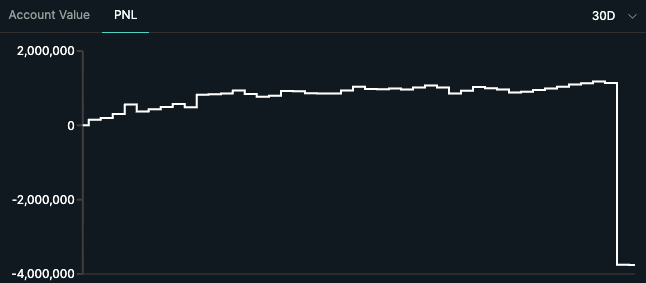Risk in onchain perps doesn't just show up in price charts—it shows up on balance sheets. Earlier today, Hyperliquid, the largest decentralized perpetuals venue by open interest, absorbed a concentrated hit to its LP vault after an orchestrated POPCAT trade forced inventory onto the protocol and triggered a short-lived safety lock on its Arbitrum bridge.
What changed in a hurry
A trader amassed a sizable POPCAT long—initially around $20 million notional—and scaled it nearer to $30 million. Instead of defending the position, they allowed it to liquidate. The trader reportedly ate roughly $3 million in losses on that liquidation, but the maneuver left Hyperliquid's HLP vault holding more than $25 million of POPCAT inventory. As that position was worked down amid selling pressure, HLP realized a loss of about $4.9 million, pushing the vault's 30-day return to roughly -1%.
Why that's a known attack surface
This playbook echoes a March incident involving JELLYJELLY: build a large position in a thinly traded asset, then let liquidation mechanics hand the resulting inventory to the LP vault, which must unload into a stressed market. It's less about price manipulation and more about exploiting inventory transfer dynamics in long-tail markets.
By the numbers
- Notional long built: ~$20M, scaled to ~ $30M
- Liquidation loss borne by the trader: ~ $3M
- Inventory transferred to HLP: > $25M of POPCAT
- Realized loss to HLP: ~ $4.9M
- HLP 30‑day return after event: about -1%

How Hyperliquid responded
The team paused deposits and withdrawals for the HLP product to manually close the exposure and stabilize the vault. During that process, the Arbitrum bridge's automated safety logic kicked in, temporarily disabling deposits and withdrawals to Hyperliquid itself. A Hyperliquid developer, Iliensinc, told the community in Discord that the lock was triggered under intentionally conservative criteria and was lifted after roughly 25 minutes once the review concluded. They emphasized that user funds remained safe, the Hyperliquid chain was unaffected, and there was no downtime.
Market's quick take
Hyperliquid's native token HYPE slid under $38 during and after the event but subsequently rebounded to about $38.8 at the time of writing—suggesting the market viewed the incident as contained rather than existential.
Why it matters beyond one vault
- Inventory risk in perps DEX design: AMM- or vault-based counterparties can inherit large bags of illiquid assets through liquidations, making exit timing and slippage the real battleground.
- Guardrails and sizing: Caps on open interest, dynamic haircuts, and asset tiering become critical when listing volatile, thinly traded memecoins.
- Bridging as a safety valve: Auto-locks that halt flows are functioning as circuit breakers, but they also spotlight operational dependencies that can momentarily affect user flow.
- User perception: Rapid communication and a brief lock with clear rationale can limit token spillover, but repeated incidents could pressure protocols to tighten listings or adjust liquidation engines.
The bigger trend: long-tail perps meet meme volatility
Memecoin listings attract flow, yet they concentrate tail risk. As more perps DEXs chase long-tail volume, we're likely to see continued tension between growth and risk controls—particularly around liquidation cascades, index pricing, and inventory offloading. Centralized venues mitigate with dedicated market makers and inventory agreements; decentralized designs must encode those safeguards into parameters and governance.
What to watch next
- Parameter changes: Potential updates to open interest limits, funding, or liquidation penalties for long-tail markets like POPCAT.
- Vault protections: Whether HLP introduces new sizing rules, asset tiering, or dynamic risk haircuts to reduce inventory transfer during liquidations.
- Bridge policy: Any refinements to the Arbitrum bridge lock criteria and incident response playbooks.
Bottom line: The episode underscores a core truth of onchain derivatives—throughput and composability are strengths, but inventory risk is real. Hyperliquid contained the immediate spillover; the next step is hardening the perimeter so a clever liquidation can't turn into a vault-size problem.
